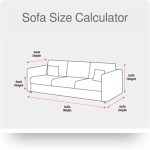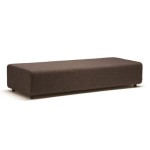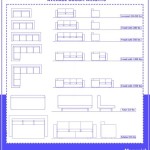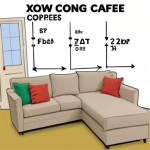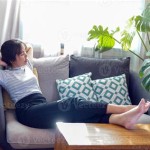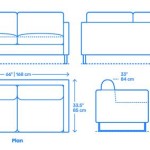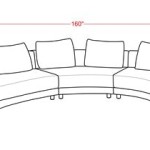Sectional Sofa Standard Size: A Comprehensive Guide
Sectional sofas have become increasingly popular in modern homes due to their versatility and ability to accommodate various room sizes and configurations. Understanding the standard sizes of sectional sofas is crucial when planning a living space, ensuring comfortable seating, and optimizing the flow of traffic. This article provides a detailed overview of standard sectional sofa dimensions, configurations, and factors that influence size selection.
Understanding Sectional Sofa Configurations
Before delving into specific measurements, it's essential to understand the common configurations of sectional sofas. These configurations influence the overall dimensions and suitability for particular spaces. The most popular configurations include:
L-shaped Sectionals: These consist of two sofa sections joined at a right angle, forming an "L" shape. They are ideal for corners and can maximize seating in smaller rooms.
U-shaped Sectionals: These feature three sofa sections, with a middle section flanked by two side sections, creating a "U" shape. They are well-suited for larger rooms and provide ample seating for gatherings.
Modular Sectionals: These consist of individual pieces that can be arranged in various configurations, offering flexibility in terms of size and shape. These pieces typically include armless chairs, corner pieces, ottomans, and chaises.
Curved Sectionals: These feature a gentle curve rather than sharp angles, offering a more conversational and visually appealing seating arrangement. They are often larger than L-shaped sectionals.
Sectionals with Chaises: These include a chaise lounge on one or both ends, providing a comfortable spot for lounging and relaxation. The chaise adds depth to the sectional's overall dimensions.
Standard Sectional Sofa Dimensions
While the term "standard size" can be somewhat misleading due to the vast array of sectional styles and configurations, it's possible to identify common dimension ranges for popular styles. These ranges provide a starting point for determining the appropriate size sectional for a specific room.
L-Shaped Sectional Dimensions:
The overall dimensions of an L-shaped sectional typically range from 80 to 120 inches in width (across the back of the sofa) and 80 to 120 inches in depth (the length of the chaise or the side section extending from the corner). The height usually falls between 30 and 40 inches.
Smaller L-shaped sectionals may measure around 80-90 inches by 80-90 inches, suitable for apartments or smaller living rooms. Larger L-shaped sectionals can extend to 110-120 inches by 110-120 inches, providing more seating and taking up more space.
U-Shaped Sectional Dimensions:
U-shaped sectionals are significantly larger than L-shaped sectionals, typically ranging from 100 to 160 inches in width and 100 to 160 inches in depth. The height remains similar, between 30 and 40 inches.
The back width measurement refers to the total width of the sectional along the back wall. The depth measurement refers to the length of each side extending from the middle section. These dimensions can vary considerably depending on the number and size of the individual sections.
Modular Sectional Dimensions:
Modular sectionals offer the greatest flexibility in terms of size. Each individual module, such as an armless chair, corner piece, or ottoman, will have its own dimensions. Armless chairs typically measure 25-35 inches wide, corner pieces measure 35-40 inches wide and deep, and ottomans vary in size depending on their function.
The overall dimensions of a modular sectional will depend entirely on the number and configuration of the modules used. This allows for customization to fit specific room sizes and seating needs.
Sectional Height and Depth Considerations:
In addition to width and depth, height and seat depth are also important considerations. The overall height of a sectional (typically 30-40 inches) affects its visual impact and how it fits within the room's architecture. Seat depth (the distance from the front of the seat to the back cushion) influences comfort and how much space is available for lounging.
Standard seat depths range from 20 to 25 inches. Deeper seat depths of 25 inches or more are often preferred for lounging, while shallower seat depths may be more suitable for formal seating arrangements.
Factors Influencing Sectional Sofa Size Selection
Choosing the right size sectional sofa involves considering several factors beyond just the available floor space. These factors include the room's function, the number of occupants, the style of the sofa, and the surrounding furniture.
Room Size and Layout:
The dimensions of the room are the most critical factor in determining the appropriate size sectional. It's essential to measure the available space accurately and consider the placement of doorways, windows, and other architectural features. Leave sufficient clearance around the sectional for comfortable traffic flow. A general rule of thumb is to allow at least 18-24 inches of walking space around furniture.
For smaller rooms, an L-shaped sectional or a smaller modular sectional may be the best option. Larger rooms can accommodate U-shaped sectionals or more expansive modular configurations. Consider the shape of the room as well. A long, narrow room may benefit from a straight sectional, while a square room may be better suited for an L-shaped or U-shaped sectional.
Seating Needs:
The number of people who will regularly use the sectional is another important consideration. If the sectional is primarily for family use, a larger configuration with ample seating may be necessary. If it's primarily for individual use or for occasional guests, a smaller sectional may suffice.
Consider the seating capacity of each section. A typical sofa section can comfortably seat two to three adults. Take into account any specific needs, such as providing enough space for reclining or lounging.
Style and Design Preferences:
The style of the sectional can also influence its size. Modern, minimalist sectionals often have cleaner lines and smaller footprints than traditional, more ornate sectionals. The style of the sectional should complement the overall design of the room.
Consider the height of the back cushions and armrests. Higher back cushions provide more support but can also make the sectional appear larger. Wider armrests can add to the overall width of the sectional.
Existing Furniture and Accessories:
The presence of other furniture and accessories in the room should also be taken into account. The sectional should be proportional to the other furniture and not overwhelm the space. Consider the placement of coffee tables, side tables, lamps, and rugs. The sectional should complement these items and create a cohesive and balanced look.
Avoid overcrowding the room with too much furniture. A well-designed living room should have a sense of openness and flow. Consider using visual aids, such as floor plans or 3D models, to visualize the placement of the sectional and other furniture before making a purchase.
Doorway Clearance and Delivery Considerations:
Before purchasing a sectional, it's crucial to ensure that it can be delivered and maneuvered through doorways and hallways. Measure the width and height of all doorways and hallways leading to the room where the sectional will be placed. Also, consider any tight corners or staircases that may present challenges.
Some sectionals are designed to be disassembled for easier delivery. Inquire about the delivery options and whether assembly is included. If the sectional cannot be delivered in one piece, ensure that the assembly process is straightforward and that all necessary tools and instructions are provided.
Seat Height and Depth as Ergonomic Factors:
Ergonomics play a crucial role in the comfort and functionality of a sectional sofa. Seat height, the distance from the floor to the top of the seat cushion, influences how easily one can sit and stand. Standard seat heights typically range from 16 to 20 inches. Taller individuals may prefer a slightly higher seat height, while shorter individuals may find a lower seat height more comfortable.
As previously mentioned, seat depth is also a key factor in comfort. A deeper seat depth allows for more lounging and relaxation, while a shallower seat depth may be more suitable for formal seating. Consider the intended use of the sectional when selecting the appropriate seat depth.
Fabric and Material Considerations:
While not directly related to size, the fabric and material of the sectional can influence its perceived size and style. Lighter colored fabrics can make a sectional appear larger and more airy, while darker colored fabrics can make it appear smaller and more grounded. The texture of the fabric can also affect its visual impact. Smooth, sleek fabrics can create a more modern look, while textured fabrics can add warmth and character.
Consider the durability and maintenance requirements of the fabric when making a selection. Fabrics that are resistant to stains and wear are ideal for families with children or pets. Regular cleaning and maintenance will help to prolong the life of the sectional and keep it looking its best.
In summary, determining the appropriate sectional sofa size requires careful consideration of room dimensions, seating needs, style preferences, and practical factors such as doorway clearance. A well-chosen sectional can become the focal point of a living space, providing comfortable seating and enhancing the overall aesthetic. Accurate measurements, thoughtful planning, and attention to detail are essential for selecting the perfect sectional for any home.

Sectional Sofa Dimensions Sizes Guide

Blu Dot New Standard Small Sectional Sofa 2modern

Nestfair 85 In Square Arm 3 Piece Velvet L Shaped Sectional Sofa Light Gray With Storage S10045a The Home Depot

Sofa Design Leather Sectional Sofas Fabric

Bennett Red

Noble House 5 Piece Light Gray Polyester 4 Seater L Shaped Sectional Sofa With Wood Legs 12164 The Home Depot

Serena Top Grain Full Leather 2 Piece Left Bumper Chaise Sectional Sofa In Cognac

Modern U Shaped Convertible Sectional Modular Storage Sofa Couch

Four Seasons Jordan L Shaped Slipcover Modular Sectional Sofa Jennifer Furniture

Sofa Design Ideas Choose Right For Your Living Room

